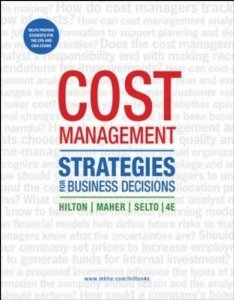Description
Management Accounting Information for Decision-Making and Strategy Execution
Management Accounting Information for Decision-Making and Strategy Execution Atkinson Kaplan Matsumura
Management Accounting Information for Decision-Making and Strategy Execution Atkinson Kaplan Matsumura 6th
Management Accounting Information for Decision-Making and Strategy Execution Atkinson Kaplan Matsumura 6th Solutions Manual
Management Accounting Information for Decision-Making and Strategy Execution Atkinson 6th Edition Solutions Manual
***THIS IS NOT THE ACTUAL BOOK. YOU ARE BUYING the Solutions Manual in e-version of the following book***
Name: Management Accounting Information for Decision-Making and Strategy Execution
Author: Atkinson Kaplan Matsumura
Edition: 6th
ISBN-10: 0137024975
Type: Solutions Manual
– The file is either in pdf, doc, rtf or zipped in the package and can easily be read on PCs and Macs.
– Delivery is INSTANT. You can download the files IMMEDIATELY once payment is done.
If you have any questions, please feel free to contact us. Our response is the fastest. All questions will always be answered in 6 hours., most of the time within 30mins
We also faced similar difficulities when we were students, and we understand how you feel.
But now, with the Management Accounting Information for Decision-Making and Strategy Execution 6th Solutions Manual, you will be able to
* Anticipate the type of the questions that will appear in your exam.
* Reduces the hassle and stress of your student life.
* Improve your studying and also get a better grade!
* Get prepared for examination questions.
* Can save you time and help you understand the material.
This is the quality of service we are providing and we hope to be your helper.
Delivery is in the next moment. Solutions Manual is accurate.
Prepare to receive your Management Accounting Information for Decision-Making and Strategy Execution 6th Solutions Manual in the next moment.
ISBN-10: 0137024975
If you have any questions, or would like a receive a sample chapter before your purchase, please contact us at inquiry@testbankcorp.com
Management Accounting Information for Decision-Making and Strategy Execution
Management Accounting Information for Decision-Making and Strategy Execution Atkinson Kaplan Matsumura
Management Accounting Information for Decision-Making and Strategy Execution Atkinson Kaplan Matsumura 6th
Management Accounting Information for Decision-Making and Strategy Execution Atkinson Kaplan Matsumura 6th Solutions Manual
Management Accounting Information for Decision-Making and Strategy Execution Atkinson 6th Edition Solutions Manual
Chapter 1
How Management Accounting Information Supports Decision Making
QUESTIONS
1-1 Management accounting is a discipline that designs planning and performance measurement systems, using financial and nonfinancial information, to help an organization develop and implement its strategy. The information must be relevant and helpful, and customized to serve multiple purposes, such as making decisions, allocating resources, and monitoring, evaluating, and rewarding performance. Information for the “plan” and “do” steps of the PDCA cycle includes prospective data on costs, profits, efficiency, and quality associated with alternative ways to produce or provide goods or services. Information for the “check” and “act” steps includes assessments of how well the organization is achieving its objectives. Common information requirements include measures of cost, quality, profitability, and timeliness.
1-2 A company’s operators, managers, and executives need information for their operational control and improvement activities, as well as on the performance of their individual processes, products, services, and customers. This information is important to direct managers’ attention to areas where improvement is needed, to provide feedback on activities, and to monitor and evaluate the performance of operators, departments, divisions, and business units and their managers. This information should be created and produced based on the internal need for operational and strategic information.
Shareholders and external suppliers of capital are not involved in managing the business or establishing and validating the company’s strategy. Therefore, they do not need the timely and disaggregate information generated for internal managerial uses. External capital suppliers will receive less timely (typically quarterly for shareholders, monthly for creditors) and more aggregate information. Also the form and accounting procedures used to prepare these external reports are constrained by regulation—such as by the country’s standard setting authorities and governmental regulatory agencies. This information may also have to be audited by independent accountants, whereas the data for internal uses do not have to be subjected to external auditing review.
Another constraint on information supplied externally is the risk of competitors seeing and acting upon a company’s disclosed information. Therefore, while internal information should be highly relevant about the success of the company’s strategy, such information disclosed externally could harm the company.
1-3 Operators need direct measures on variables they can influence and control. These generally are physical measures of outputs produced and input resources used to produce the outputs (including productivity measures such as percentage of good units produced). In addition, operators should be seeing measures of the quality of their output (defects, scrap, and rework) and the time required to produce the output. In this way, they can become problem solvers and attempt to improve quality, productivity, and cycle times of their tasks and activities. Financial measures are a summary of the effectiveness and efficiency (or lack thereof) of operators’ actions, but by themselves do not direct attention to the drivers of improved financial performance or the root causes of poor financial performance. Operators need leading measures of performance, and financial measures tend to be lagging measures of performance.
Middle managers, while generally seeing more financial information than operators, will also need to see summary measures about outputs produced (first-pass yields, productivity), quality (scrap, rework, defect rates) and cycle times if they are going to motivate employees for continuous improvement of yields, quality and production process times. The middle managers will also want to see operating summaries of the performance of their operations from their customers’ perspectives (including internal customers), such as measures of on-time delivery, quoted and actual lead times for delivery, returns due to defects or dissatisfaction, and customer satisfaction. They may also want periodic summaries about their employees’ attitude, skills, number of suggestions made, absenteeism, turnover, etc.
Even senior executives can benefit from seeing nonfinancial measures. Measures such as market share, customer satisfaction, retention and acquisition of customers, on-time delivery performance, employee morale, and summaries of the quality, yield, productivity, safety, and timeliness of key business processes can provide valuable information to senior executives about the success of their strategic initiatives and the efficiency of internal operations.
1-4 Financial measures are inadequate for guiding and evaluating organizations’ trajectories through today’s competitive environments. Financial measures are lagging indicators that could fail to capture much of the value that has been created or destroyed by managers’ actions in the most recent accounting period. The financial measures tell some, but not all, of the story about past actions and they fail to provide adequate guidance for the actions that have created or destroyed future financial value.
The information-age environment for both manufacturing and service organizations requires new capabilities for competitive success. The ability of a company to mobilize and exploit its intangible or invisible assets has become far more decisive than investing and managing physical, tangible assets. Intangible assets enable an organization to:
• develop customer relationships that retain the loyalty of existing customers and enable new customer segments and market areas to be served effectively and efficiently;
• introduce innovative products and services desired by targeted customer segments;
• produce customized high-quality products and services at low cost and with short lead times;
• mobilize employee skills and motivation for continuous improvements in process capabilities, product and service quality, and response times; and
• deploy information technology, data bases, and systems
Managers who are placed under pressure to deliver consistent and excellent short-term financial performance may make trade-offs that limit the search for investments in these growth opportunities. Even worse, the pressure for short-term financial performance can cause companies to reduce spending on new product development, process improvements, human resource development, information technology, databases and systems, and customer and market development. In the short run, the financial accounting model reports these spending cutbacks as increases in reported income, even when the reductions have cannibalized the company’s stock of assets and its capabilities for creating future economic value. Alternatively, the company could maximize short-term financial results by exploiting customers through high prices or lower service. In the short-run, these actions enhance reported profitability, but the lack of customer loyalty and customer satisfaction will leave the company highly vulnerable to competitive inroads.
1-5 Innovations in management accounting practice have been driven by the information needs of new strategies as companies became more complex, introduced new technologies, and encountered new competitors.
• When controlling and reducing costs were important, innovations in costing systems occurred. For example, by the middle of the 19th century, railroad managers had developed complex costing systems to compute the costs of carrying different types of freight along multiple routes. Later in the century, Andrew Carnegie developed detailed systems to track the cost of materials and labor in his steel mills. Carnegie used this information to determine where he could reduce costs and which mills to close. Based on his ability to control and reduce costs, Carnegie was able to lower prices to obtain a competitive advantage.
• When organizations gained advantage from scale and diversification, innovative executives developed new management control systems to monitor and manage their complex enterprises. For example, in the early 20th century, DuPont and General Motors expanded the focus of management accounting to management planning and control in order to determine resource allocations and assess performance of multiple lines of business. Assessment measures included return on investment and various disaggregations of return on investment.
• When competitive advantage shifted to how well a company deployed and managed its intangible assets—customer relationships, process quality, innovation, and, especially, employees—new systems for cost and performance management emerged. For example, in the 1970s, American and European companies faced intense competition from Japanese manufacturers. Management accounting systems advanced to add such nonfinancial measures as quality, service, innovation, drivers of customer satisfaction, and employee performance.
Furthermore, many companies formerly produced a fairly narrow product line. The companies produced standard products in high volumes so that product distortions did not arise from variation in batch sizes, customization, and special features. Today, most companies produce a much greater variety of products and services, and sell and distribute these to more customers and markets. As a result, they need better cost systems to accurately assign indirect and support costs required to design and produce a product, deliver a service, and meet individual customers’ demands.
• Though not covered in the chapter, commentary on service organizations is provided here: For many service organizations, the regulated environment did not require accurate knowledge of the cost of individual services or customer segments. Therefore these companies’ cost systems focused on cost control and responsibility accounting, and had only very crude estimates of cost and profitability by service, line of business, or market segment. In a much more competitive, deregulated environment, service companies now have to know the cost of their outputs and customers, and to understand the underlying cost drivers of their business. In addition to better cost and profit information, service companies have to concentrate on customer service and satisfaction, so they now need information on the quality and timeliness of their services to customers. Measures such as customer loyalty and repeat purchase frequency become critical.
• Finally, organizations today derive competitive advantage from their intangible assets: innovative products and services, high quality and responsive processes, skilled and motivated employees, excellent technology and information systems, and reputation and image among targeted customer groups. None of these “assets” is well measured by traditional accounting systems. Consequently, management accounting systems in such organizations have advanced to include measures to help coordinate value creation from the organization’s intangible assets.
1-6 Given a selected strategy, the organization needs management accounting information to help implement the strategy, allocate resources for the strategy, communicate the strategy, and link employees and operational processes to achieve the strategy. As the strategy gets executed, management accounting information provides feedback about where it is working and where it is not, and guides actions to improve the performance from the strategy.
1-7 The plan step of the PDCA cycle defines the organization’s purpose, selects the focus and scope of its strategy, and determines actions to achieve the organization’s objectives.
The do step involves implementing a chosen course of action.
The check step includes two components: measuring and monitoring ongoing performance and taking short-term actions based on the measured performance.
In the act step, managers take actions to lower costs, change resource allocations, improve the quality, cycle time, and flexibility of processes, modify the product mix, change customer relationships, and redesign and introduce new products. They reward (and occasionally punish) employees based on performance. As these new actions get implemented, the management team will eventually return to the planning step to assess whether its previous plan is still valid and worth continuing, or whether it has become time to adapt the plan or perhaps introduce a new strategic plan. This launches the enterprise on another trip around its PDCA cycle.







Reviews
There are no reviews yet.